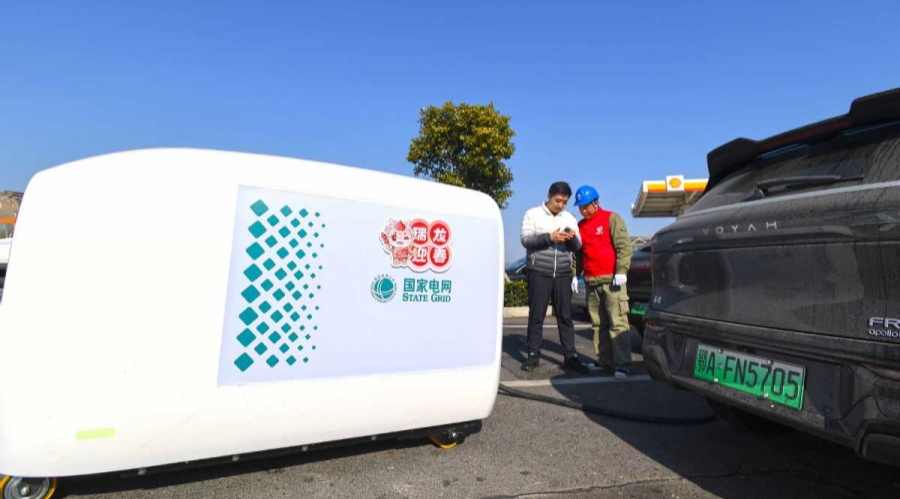
A State Grid employee (right) helps a driver charge his electric vehicle with a robot charger on a highway service area in Hubei province on Tuesday. [Photo provided to China Daily]
State Grid Corp of China — the world's largest utility company — has adopted an innovative approach to mobile charging solutions by using autonomous electric vehicle charging robots during the Spring Festival holiday this year.
At city charging stations and highway service centers, the robots have been busy locating vehicles and charging them when fixed charging slots are occupied. The attempt has not only helped in meeting the record-high road trips but also bolstered green charging services nationwide during the holiday that fell between Feb 10 and 17, the company said.
State Grid Wuhan Power Supply Co has used 20 mobile EV charging robots in high-traffic service areas this year to address the surge in demand.
The remote-controlled charging robots have been providing emergency charging services for new energy vehicles by traveling to the destination themselves within 2 kilometers. They are transported to the site with the help of staff members beyond 2 kilometers.
Each mobile charging station can simultaneously provide fast charging services for four NEVs, meeting the daily charging needs of up to 200 vehicles. The daily charging capacity can exceed 4,000 kilowatt-hours, providing crucial support to NEV owners during their return journeys, it said.
"Equipped with 60-kilowatt fast-charging capabilities, these mobile robots can efficiently charge six to seven vehicles when fully charged," said Yin Zhengsheng, deputy general manager of the public facilities management unit of State Grid Wuhan Power Supply Co.
The strategic deployment of these robots at busy highway locations is convenient for electric vehicle owners during their travels, streamlining return trips and marking a significant leap in charging efficiency, he added.
As the number of EVs in China is projected to reach 30 million units by the end of the year, the need for efficient charging facilities is more pressing than ever, highlighting the rapid growth of the EV market, said Zhang Yongwei, secretary-general of China EV100, an NEV industry think tank.
Recognizing the increased demand for EV charging infrastructure, State Grid is already coming up with autonomous EV charging robots in Tianjin, as well as Jiangsu, Zhejiang, Hubei and Fujian provinces, and is poised for further expansion nationwide.
It will consider the traffic flow and charging lines at public charging stations in service areas along expressways, tourist attractions and major travel destinations in advance.
Authorities have forecast that during the entire 40-day span of the Spring Festival holiday travel rush, which runs from Jan 26 to March 5, Chinese residents will make 9 billion trips, 80 percent of which will be through private vehicles.
An analyst said the company's approach is part of an initiative to understand the prospects of the country's NEV market.
The installation of mobile charging stations and the introduction of charging robots in high-traffic service areas were pivotal moves, demonstrating a commitment to optimizing electric vehicle charging processes and facilitating a seamless return journey for owners, said Luo Zuoxian, head of intelligence and research at the Sinopec Economics and Development Research Institute.
As travel across China ramped up, leading to long lines of EVs at charging stations, the company's initiative will not only offer quicker charging services but also capitalize on the growing demand for EV charging solutions, he said.
To further facilitate the holiday travel, State Grid has asked its subsidiaries nationwide to organize service teams, conducting special patrols in expressway service areas before the travel rush, at tourist attractions and bus charging stations, to eliminate hidden dangers in charging equipment for reliable operations.
State Grid has also established an emergency response system for charging services, monitoring the operational status of charging equipment in real-time, through its vehicle networking platform and requiring duty workers to stand round-the-clock shifts, in a bid to meet NEV drivers' needs on time, it said.